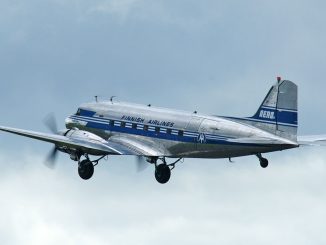
The Douglas DC-2 is a, twin-propeller airliner produced by the Douglas Aircraft Corporation.
| Role | Passenger & military transport |
|---|---|
| Manufacturer | Douglas Aircraft Company |
| First flight | May 11, 1934 |
| Introduction | May 18, 1934 with Trans World Airlines |
| Status | Retired |
| Primary users | Transcontinental & Western Air (TWA) KLM Pan American Airways |
| Produced | 1934–1939 |
| Number built | 198 |
| Developed from | Douglas DC-1 |
| Developed into | Douglas B-18 Bolo Douglas DC-3 |
The DC-2 was developed in 1933 when TWA and the Douglas Aircraft Company decided to increase the fuselage length of the DC-1 (one built) passenger plane by two feet — adding one additional row of seats, increasing the seat capacity to 14.
The early DC-2 were so successful that by June 1934 orders for 75 aircraft had been received from airlines in both the US and abroad. Subsequent orders were received from American Air Lines, Eastern Airlines, Pan American Airways.
The DC-2 was the first Douglas airliner to enter service with an airline outside the United States. In October 1934, KLM Royal Dutch Airlines entered one of its DC-2s in the London-to-Melbourne, Australia, air race. It made every scheduled passenger stop on KLM’s regular 9,000-mile route (1,000 miles longer than the official race route), carried mail and even turned back once to pick up a stranded passenger. Yet the DC-2 finished in second place behind de Havilland Comet racing plane built especially for the competition. After that, the DC-2’s reputation was assured, and it became the airplane of choice for many of the world’s largest airlines.
The safe, comfortable, and reliable Douglas DC-2 was soon overshadowed when, in 1935, an improved version, the famous Douglas DC-3, flew for the first time.
General characteristics
- Crew: 2-3
- Capacity: 14 passengers
- Length: 19.1 m (62 ft 6 in)
- Wingspan: 25.9 (85 ft 0 in)
- Height: 4.8 (15 ft 10 in)
- Wing area: 87.3 sq m (940sq ft)
- Empty weight: 5,650 kg (12,455 lb)
- Loaded weight: 8,420 kg (18,560 lb)
- Powerplant: 2x Wright Cyclone GR-F53 9-cylinder radial engines, 730 hp (540 kW) each
Performance
- Maximum speed: 338 km/h (210 mph at 6,800ft)
- Combat radius: 1,750 km (1,085 mi)
- Service ceiling: 6,930 m (22,750 ft)
- Rate of climb: 310 m/min (1,030 ft/min)










Nice bird. It was a pity only 198 have been built. Thank you very much for sharing.